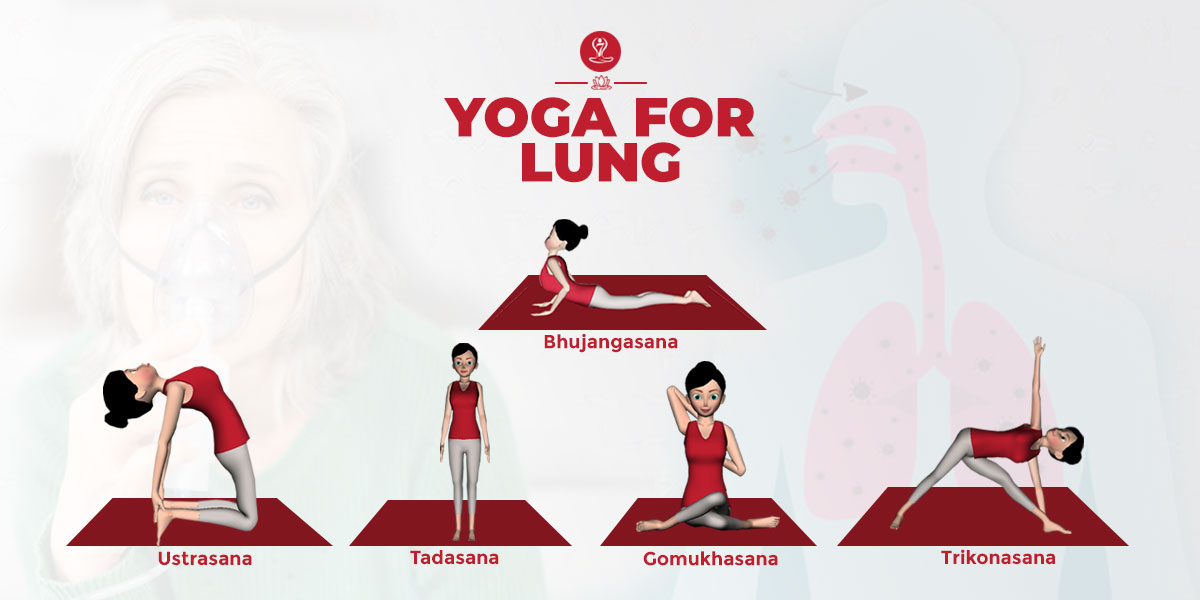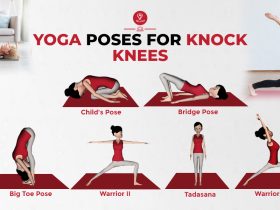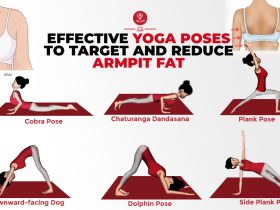
Yoga for lungs helps to control prana or vital life energy, ultimately for the body and mind.
Yoga has been recognized for centuries as a holistic practice that benefits not only physical fitness but also mental and emotional well-being. When it comes to lung health, yoga offers a range of practices that can have profound effects on respiratory function.
At the core of yoga’s impact on lung health are its emphasis on breath control (pranayama) and the performance of specific physical postures (asanas) that promote deep breathing and open the chest. Through these practices, yoga can improve lung capacity, strengthen respiratory muscles, enhance respiratory efficiency, and promote relaxation, all of which contribute to better respiratory health.
With gentle breathing-based exercises like Tai Chi or Yoga, as well as techniques such as Bhastrika Pranayama, Anulom Vilom Pranayama and Kapal Bhati, you can improve your physical and emotional health. Apart from this, these techniques help expand lung capacity, clear respiratory passages, and promote relaxation, reducing stress-related breathing issues.
Below are some suggestions for gentle exercise, including abdominal, thoracic, and clavicular breathing. All these yogasanas are known to gain breath control, improve lung efficiency, improve breathing habits, and absorb oxygen. And also help in stretch and strengthen the muscles involved in breathing, facilitating better oxygen exchange and carbon dioxide removal.
In short, No one better than turning to yoga poses for healthy lungs.
Poses of yoga for lungs health
Yoga is not just limited to Asanas, but is more than it. Simply put, it is to take care of your mind, body and breath. In yoga, through yogasana, pranayama and meditation, you learn to reconcile the mind, breathing and various parts of the body.
20 minutes of yoga practice can help strengthen lungs, clear nasal passages, oxygenation and increase lung capacity.
Standing Tadasana / Mountain Pose
Tadasana can release accumulated tension and helps open up the chest muscles. This stretches most of the muscles and fills the lungs with plenty of fresh air. Along with this, it also improves your balance.
Steps to do:
- First of all, stand up straight by mixing the two toes or keeping them at a distance. Keep the arms on the side.
- Keep your body weight the same on both legs.
- Now raise your hands above the head.
- Keep the palms facing up by trapping the fingers of the hands.
- Hold the vision at some point in a straight line.
- Then lift the eddy up and stand on the feet.
- Now take a breath and stretch the whole body upward with arms, shoulders and chest.
- Stretch your entire body from the claws to the head towards the sky and stand in this position by crying breath for a few bones.
- After this, while exhaling, come back to the posture and rest for a few seconds.
To know more about: Tadasana Steps, Benefits, and Precautions.
Trikonasana / Triangle Pose
Trikonasana stretches the chest and opens up the rib cage, facilitating better lung function. It also improves posture and balance.
Steps to do:
- First of all, stand upright on a mat or on the floor to practice this asana.
- Then spread both your legs by 3 to 4 feet.
- Keeping your neck straight, raise both your hands up and keep them in line with both your shoulders.
- Then keep your left leg straight, rotate your right foot outward by 90 degrees.
- Take a long deep breath, then while exhaling, try to touch the heel of the right foot with the claws of your right hand.
- Then keep your left hand absolutely straight up towards the sky.
- Breathed in form and then stayed in this state for a while.
- While breathing slowly, come upwards and straighten the right leg.
- Repeat the same process from your left side.
To know more about: Trikonasana Steps, Benefits, and Precautions.
Bhujangasana / Cobra Pose
This asana opens up the chest, stretches the lungs, and improves breathing capacity. It also strengthens the spine and stimulates abdominal organs.
Bhujangasana is very useful for keeping your back healthy (yoga for Back Pain). Practice this asana in person or through Surya Namaskar to make your spine strong and very agile.
Steps to do:
- Lie down on your stomach on the floor.
- Extend your legs backward, keeping your toes on the floor.
- Spread your palms on the floor beneath your shoulders and bring your elbows close to the sides of your body.
- Press the tops of the feet and thighs firmly into the floor.
- As you inhale, press your palms into the floor and begin to straighten the arms to lift the chest off the floor.
- While maintaining connection with your pelvis on the floor, lift your navel as high as you can.
- Gently squeeze and firm your buttocks while pushing your navel center downwards.
- Be strong as you engage your shoulder blades to open up your chest more.
- Make sure you are bending evenly over the entire spine.
To know more about: Bhujangasana Steps, Benefits, and Precautions.
Gomukhasana / Cow Face Pose
Gomukhasana is a very beneficial yoga for lung health. This asana not only opens the chest area but also keeps the mind calm and reduces stress and anxiety. In this asana you will feel an increase in breathing and heart rate. It gives warmth and strength.
Steps to do:
- To do Gomukhasana, first of all we will straighten both our legs in front.
- After this, bend your right leg from the knee and place it till the buttocks of the left leg, after this, lift the left leg with both hands and bend it from the knee and place it above the right knee of the right leg and see. If both knees are up then they are down.
- If both knees are up and down, the position is correct.
- After this, you will lift your left hand straight and after lifting it, bring that hand backwards near the back.
- Now take the right hand from behind and hold the left hand.
- Keep in mind that whatever leg is on top, the same hand will be on top.
To know more about: Gomukhasana Steps, Benefits, and Precautions.
Ustrasana / Camel Pose
Ustrasana is one of the best yoga asanas for the lungs and heart, which reduces the major adversity of the body. It promotes the opening of the heart chakra, awareness of breath and sensations, and good health and well-being. When we are in a camel pose the Anahata Chakra opens which allows powerful energy to flow freely to enrich life.
The pose stretches the chest and lungs, improving respiratory efficiency. It also helps in correcting posture and reducing stress.
Steps to do:
- First of all, bend your knees with your knees and sit in Vajrasana.
- Stand on your knees, in this case, the knees and ankles of both your legs should be adjacent.
- Place the palms back at the waist, your fingers should be facing down.
- Inhale and bend slightly back from the waist, place the palms on the heel, place the right palm on the heel of the right foot and the left palm on the heel of the left foot.
- Note that your chest should be open.
- Your elbows and shoulders should be parallel and your thighs should be equal to 90 degrees from the ground.
- Inhale normally and maintain this position for 30 to 60 seconds.
- Stand back on your knees while exhaling slowly.
- Now sit in Vajrasana and slowly spread both the legs towards the front, in this case you rest for a while.
To know more about: Ustrasana Steps, Benefits, and Precautions
Anjaneyasana / Low Lunge Pose
Anjaneyasana stretches the chest and lungs, improving breathing capacity. It also strengthens the legs and stretches the hip flexors.
- Begin in a standing position at the top of your mat, with your feet hip-width apart.
- Step your right foot back behind you, placing the ball of your right foot on the mat.
- Gently lower your right knee to the mat, ensuring it aligns directly under your right hip.
- Keep your left knee directly above your left ankle, forming a right angle with your left thigh parallel to the ground.
- Square your hips towards the front of the mat by gently drawing your right hip forward and your left hip back.
To know more about: Anjaneyasana steps and benefits
Ardha Matsyendrasana / Half Lord of the Fishes Pose
This twisting asana massages the abdominal organs, including the lungs, and improves lung function. It also enhances spine flexibility.
- Sit on the mat with your legs extended in front of you, spine tall and shoulders relaxed.
- Bend your right knee and place your right foot on the outside of your left thigh, with your right knee pointing up towards the ceiling.
- Bring your left foot to the outside of your right hip, placing it flat on the mat.
- Inhale to lengthen your spine, then exhale as you twist to the right, bringing your left elbow to the outside of your right knee.
- Place your right hand behind you on the mat for support, with fingertips pointing away from your body.
- Gently press into the floor with your right hand and left foot as you deepen the twist.
- Keep your spine long and chest lifted, and gaze over your right shoulder if comfortable.
To know more about: Ardha Matsyendrasana steps and benefits
Conclusion
All these yoga for lungs stretch out the lungs and stretching and strengthening the lung muscles. These yogic postures are known to alleviate stress, activating the air-cells of the lungs, and improve the efficiency of lungs.
Keep in mind that yoga should be done regularly. If you have a dilemma about anything, you can also consult a yoga expert.
RELATED ARTICLES
May 20, 2025
Kegel Exercises: Strengthen Your Pelvic Floor for Better Health
Kegel exercises strengthen the pelvic floor muscles, which support the uterus, bladder, small intestine and rectum. Strengthening these muscles improves[...]
Oct 06, 2024
Balance Your Body: Yoga Poses For Knock Knees (Genu Valgum)
Knock knees, or “genu valgum,” is a condition in which the knees touch each other while the ankles remain apart.[...]
Sep 20, 2024
Effective Yoga Poses to Target and Reduce Armpit Fat
Fat accumulation under the arms is a common problem for many women, which is often considered an important part of[...]
RECENT POSTS
Disclaimer
The content is purely informative and educational in nature and should not be construed as medical advice. Please use the content only in consultation with an appropriate certified medical or healthcare professional






